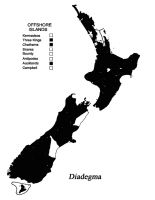ICHNEUMONIDAE: : Diadegma Förster 1869
Diagnosis:
Characteristics of Diadegma include: 1. Body size <10mm; 2. Position of spiracle on T1 clearly behind the centre; 3. Shape of aerolet in forewing triangulate; 3. Shape of aerolet in forewing: petiolate; 4. Colour of face only black; 5. Metasoma compressed laterally; 6. Size of ocelli small; 7. Length of antennae shorter than body; 8. Length of ovipositor varies more barely visibale to distinct but not longer than body; 9. Wings present; 10. Colour of wings hyaline (clear); 11. Sternaulus absent; 12. Shape of face in lateral view flat or only weakly bulging; 13. Sternite on T1 (viewed laterally) not extending past spiracle; 14. Shape of T1 (viewed laterally) evenly curved; 15. Number of teeth in mandibles 2; 16. Metasoma same colour throughout; 17. Length of T1 vs T2 subequal in length; 18. Sculpture on mesoscutum finely pitted, many hairs; 19. Width of T1 (viewed dorsally) anterior part slender often parallel, strongly widening behind spiracle; 20. Glymma on T1 present, (deep pit); 21. Sculpture on metasoma smooth with a semi-glossy or satin appearance at least on T2; 22. Propodeum reaching past coxal insertion, but not reaching halfway along metacoxae.Similarity to Other Taxa
Diadegma is most likely to be confused with other genera of Campopleginae.Compare
-

Campoplex
No Glymma. -

Casinaria
No Glymma. -

Dusona
No Glymma, >10mm in size. -

Venturia
No Glymma, >10mm in size. -

Campoletis
Glymma. Forewing with vein 3r-m present, the areolet is petiolate with 2m-cu joining between centre and proximal side whereas in Diadegma forewing with vein 3r-m present or absent. If present then areolet is either not petiolate, or if petiolate, then 2m-cu joins closer to distal side than proximal side.
Distribution in NZ
North Island: ND, AK, BP, CL, GB, HB, TK, TO, WA, WI, WN, WO, RI. South Island: NN, NC, SD, BR, MB, MC, DN, CO, OL, WD, FD, SI, MK, SL. Offshore Islands: TH, CH, AU.
Species in NZ
Three endemic species; Diadegma agens Townes, 1964; D. muelleri (White, 1874); D. novaezealandiae Azidah, Fitton & Quicke, 2000; one introduced biological control agent D. semiclausum (Hellén, 1949), and approximately 50 undescribed species.Biology & hosts
This is an extremely large genus with species occurring throughout the world (Gauld 1984). A number of species are important parasitoids of pest Lepidoptera and several of these have been spread around the world both accidentally and deliberately as biological control agents (Gauld 1984).Diadegma semiclausum was introduced into New Zealand in the early 1900s as a biological control agent to control the diamondback moth Plutella xylostella (Lepidoptera: Yponomeutidae). It is considered to give good control (Cameron et al. 1989). It also attacks other species of Lepidoptera, Exoteleia dodecella and Pieris rapae (Yu et al. 2005). At the same time, another species Diadegma fenestrale was also imported and released in New Zealand, but this is not thought to have established (Cameron et al. 1989).
Little is known about the endemic species in New Zealand. D. muelleri is a parasitoid of Morova subfasciata (Thyrididae), and D. novaezealandiae is a parasitoid of Plutella xylostella (Yponomeutidae) and Plutella antiphona (Plutellidae) (Valentine & Walker 1991, Azidah et al. 2000).
In general, there has been a problem of numerous misidentifications of species (Gauld 1984), and as a result there is uncertainty of what species are present in New Zealand, and the validity of some names. Several other scientific names listed from New Zealand include; “ Diadegma laterale ”, “ Diadegma cerophagus ” and “ Diadegma fenestrale ” (Miller 1936, Muggeridge 1930, Valentine 1967, Yu et al. 2005). An additional problem is trying to recognise species which may have been either accidentally introduced, or where records of biological control releases in the early 1900s give incomplete information, and are without voucher specimens.
Sources of information
Azidah AA, Fitton MG, Quicke DLJ. 2000. Identification of the Diadegma species (Hymenoptera: Ichneumonidae, Campopleginae) attacking the diamondback moth, Plutella xylostella (Lepidoptera: Plutellidae). Bulletin of Entomological Research. 90: 375-389.Cameron PJ, Hill RL, Bain J & Thomas WP. 1989. A Review of Biological Control of Invertebrate Pests and Weeds in New Zealand 1874-1987. Technical Communication No 10. CAB International Institute of Biological Control. DSIR Entomology Division. 424 p.
Gauld ID 1984. An Introduction to the Ichneumonidae of Australia. London, British Museum (Natural History). 413 p.Miller D. 1936.
Biological control of field crops and animal insect pests. New Zealand Journal of Science and Technology. 18: 592-593.
Muggeridge J. 1930. The diamond-back moth. Its occurrence and control in New Zealand. New Zealand Journal of Agriculture. 41: 253-264.
Townes HK, Townes M, Gupta VK. 1961. A catalogue and reclassification of the Indo-Australian Ichneumonidae. Memoirs of the American Entomological Institute. No.1. 522 pp.
Valentine EW. 1967. A list of the hosts of entomophagous insects of New Zealand. New Zealand Journal of Science. 10: 1100-1210.
Valentine EW & Walker AK. 1991. Annotated Catalogue of New Zealand Hymenoptera. DSIR Plant Protection Report 4. General Printing Services, 84 pp.
Yu DS, van Achterburg K, Horstmann K. 2005. World Ichneumonoidea 2004. Taxonomy, Biology, Morphology and Distribution. CD/DVD. Taxapad. Vancouver, Canada.
Citation
Ward DF & Schnitzler FR. 2013. Ichneumonidae of New Zealand. Genus Diadegma http://ichneumonidae.landcareresearch.co.nzAccessed: 10 March 2025


